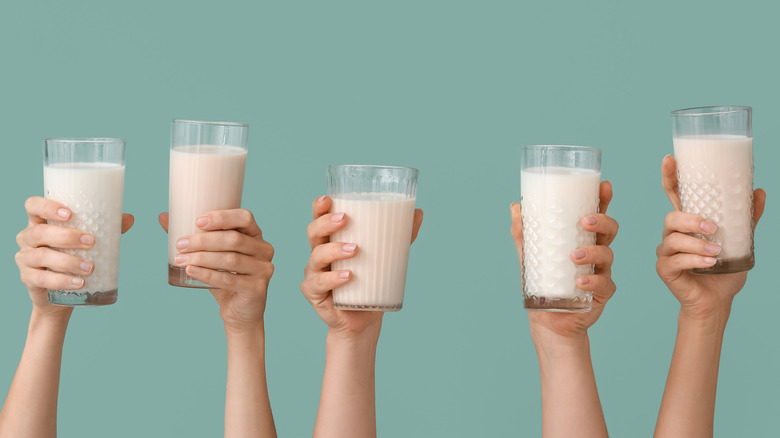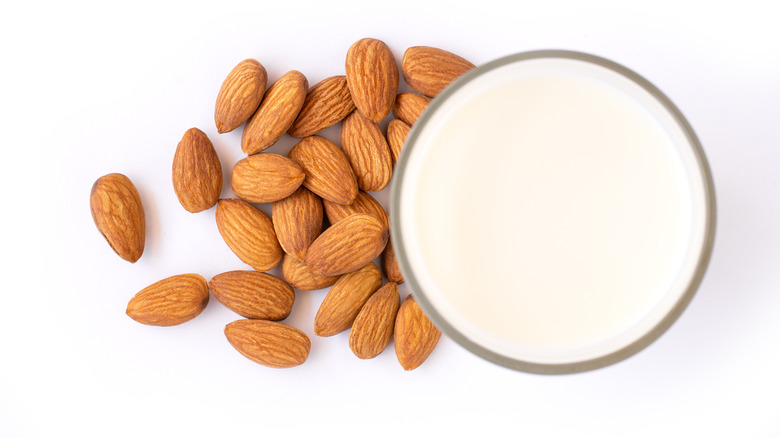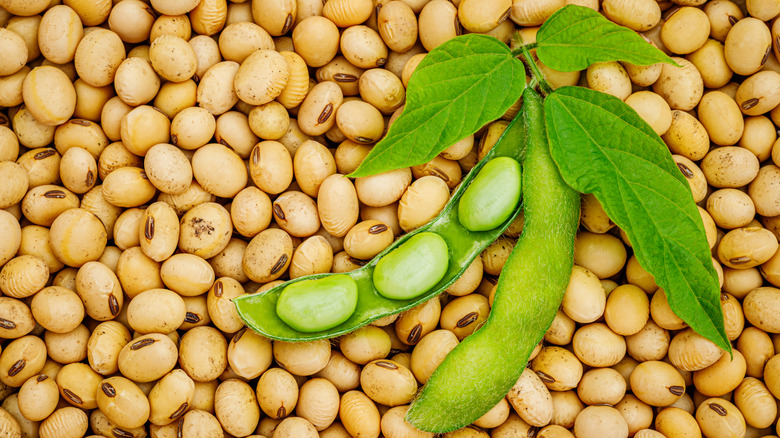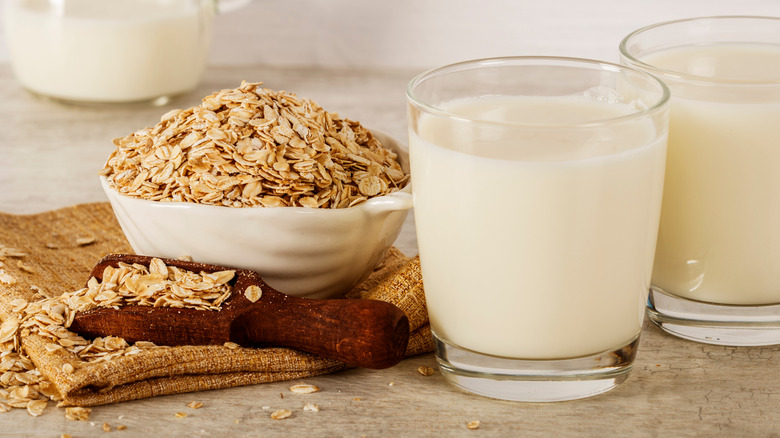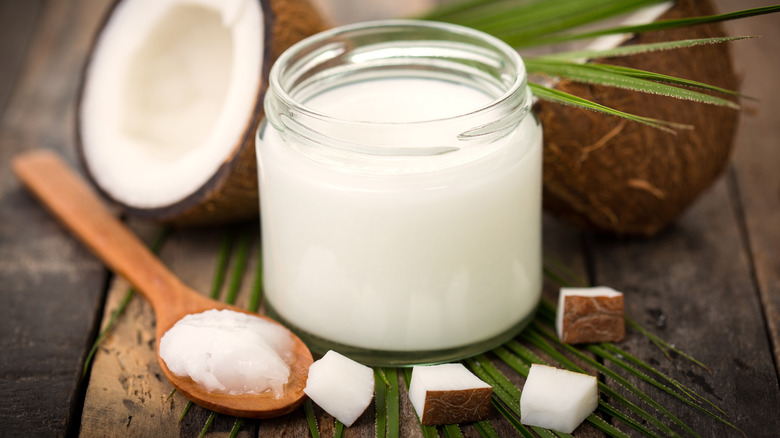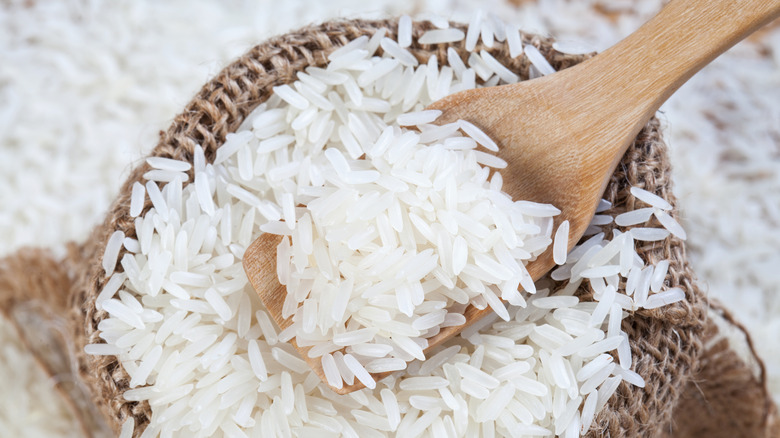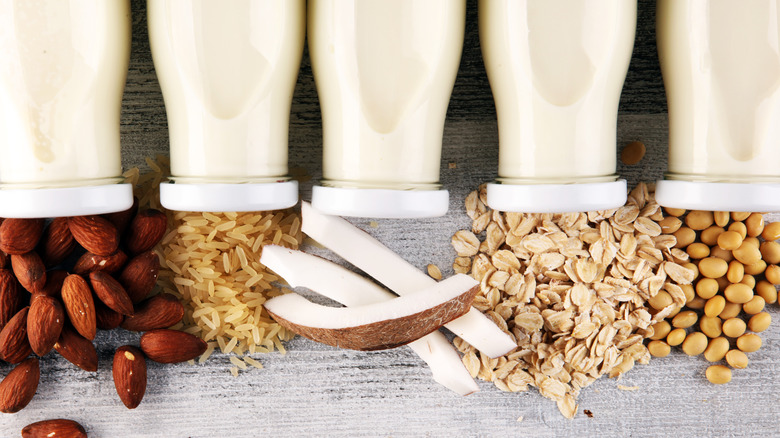Which Plant-Based Milk Is The Most Sustainable?
For many of you who are looking to consume fewer animal products, plant-based milk is the gateway product. In fact, alternative milk happens to be the largest plant-based category in North America, making up 35% of the entire market of plant-based food (via Good Food Institute). As the values of consumers shift and sales of plant-based milk alternatives grow, more and more moo-less milk options are emerging on the market. From original variations like soy to 2021's questionable introduction of potato milk, you've been sold an idea of sustainable sipping — but it's not necessarily that simple.
While any alternative milk option avoids the well-known environmental impacts of animal agriculture, other factors play a role in the sustainability of a product (via Food Print). When you consider variables like greenhouse gas emissions, water use, land use, chemical runoff, and soil degradation throughout each production stage, it becomes clear that not all plant-based milk varieties are created equal. Although it's no question that indulging in any of these alternatives is an environmentally conscious choice in comparison to cow's milk, your understanding of the unique impacts of each will allow you to think critically as new plant-based milk varieties appear on the market.
Almond milk
You probably know by now that almonds, like other tree nuts, do in fact grow on trees. However, what's not as commonly known is that the state of California grows 82% of the world's almond supply (via Los Angeles Times). Nuts, in general, have a large water footprint; a 2017 study published in Ecological Indicators found that almonds grown in California use an average of 12 liters, or around 3 gallons, of water per kernel. To make matters worse, the drought conditions in California are a serious issue due to farms using the majority of the state's "developed water," or water that's been moved and stored for human use (via Mother Jones).
In terms of greenhouse gas emissions and land use, Food Print says that almond milk isn't any better or worse than other alternative milk variations, but it does consume an excessive amount of water in an area where it is already in short supply — not to mention the deadly impact almond farming has made on honeybees (via The Guardian). Even so, a 2019 study published in The International Journal of Life Cycle Assessment discovered that dairy milk requires almost twice as much water as the equivalent amount of California almond milk. Still, in terms of alternative milk, there are options that, unlike almond milk, use less water and contain more than 2% of the base they claim to use (via Insider).
Soy milk
A 2017 study published by Life Cycle Associates showed that, when it comes to water consumption, soybeans use less than a tenth of almonds and, when compared based on water consumption per protein content, soy milk comes out even more victorious. New Mexico State University says that, like legumes, soybeans cause a chemical process in the soil known as nitrogen fixation. This reduces the need for nitrogen fertilizers that have been found to pollute groundwater, streams, estuaries, oceans, and even drinking water (via Cary Institute of Ecosystem Studies). This also applies to other legume-based protein milk, like pea and peanut milk. However, the one major drawback of soy is the amount of land it takes up.
While a lot of the large companies producing soy milk use organic or non-GMO soybeans sourced from Canada and the U.S., a 2006 report from Green Peace exposed the link between soy's rising demand for land and the destruction of parts of the Amazon Rainforest. And, while nitrogen fixation reduces the use of nitrogen fertilizers, soy production still requires the use of phosphorous fertilizers. Phosphorous fertilizers are connected to chemical runoff that creates dead zones, or areas of water where marine life cannot survive due to a lack of oxygen (via Civil Eats). So, next time you hit the grocery store to re-up on your soy-milk stock, you should think twice and opt for brands like Silk that use certified organic beans.
Oat milk
As the newest and most rapidly growing milk alternative, oat milk has won the hearts of many with its neutral flavor profile, creamy texture, and frothiness. Coming second in popularity behind almond milk (via New Zealand Foreign Affairs and Trade), oat milk delivers a comparable nutrition profile in an allergy-friendly form, without draining the water supply. According to a 2010 report from the Institute for Water Education, oats use the least amount of water than all other plants that are turned into milk. Additionally, unlike soy and almond milk, oats don't require mass amounts of land. In fact, oats can be grown locally in many parts of the world (via Tree Hugger), and are a valuable part of farm rotation systems because of their ability to improve agrobiodiversity and break pest cycles which aid in the health of the soil and minimize the need for nitrogen fertilizers (via Oatly).
Despite oat milk's low carbon dioxide emission rate of about .18 kilograms per glass (via Columbia Climate School), small water footprint, and soil benefits, it's been found that oats are often contaminated by unsafe levels of glyphosate. A report from the Environmental Working Group found that, out of the 28 samples of General Mills and Quaker oat-based products, all but two had levels of glyphosate higher than their health benchmark. Classified as a carcinogen by the World Health Organization in 2015, the impacts of glyphosate go beyond your personal health to the health of both aquatic and terrestrial environments, negatively affecting the cognitive abilities of invertebrate species such as bees, mosquitos, mussels, crayfish, and more that are the foundation of the food chain (via Environmental Health News). While most oat milk brands aren't certified organic, you can look for brands like Oatly, Rise Brewing Co., and Pacific Foods that do third-party testing to ensure that their products are glyphosate free.
Coconut milk
In terms of greenhouse gas emissions, coconut milk is low on the charts. The tree's long life span, and ability to absorb carbon dioxide from the environment help to offset coconut milk's carbon emissions (via Forbes). The trade-off is that coconuts, unlike oats, exclusively grow in far-off, tropical locations that most people only see to put their vacation days to good use. Not only does this mean your coconut milk has to travel across the world to make it into your refrigerators, but it puts more than 70% of the global production demand on the backs of countries like the Philippines, Indonesia, and India as Business Wire explains.
In order to meet the demands of the world, producers in these countries often practice mono-cropping, an agricultural method of growing one crop on the same land every year, according to Green Matters. Although the practice is profitable in the short term, Green Matters says that, over time, this method degrades the nutrients of the soil and creates a dependency on chemical fertilizers. Additionally, a 2020 study (via Food Tank) published in the journal Nature Geoscience found that mono-cropping alters the water cycle and disrupts the planet's ecological stability, which only makes it more challenging for Earth to rebound from climate change. On the other hand, Forbes says that coconut trees are able to absorb even more carbon when intercropped with other plants. The hope is that, through different initiatives, coconut farmers will receive the support needed to develop sustainable farming methods and diversify their crops.
Rice milk
As a staple food, rice provides over 16% of the calories consumed across the globe (via World Atlas). While it may come at a friendlier price point, rice milk uses a comparative amount of water to almond milk, leveling out to about 54 liters of water per glass (via BBC News). Even though that's still less than a glass of dairy milk, rice offers little nutritional or environmental value compared to other milk alternatives. Because rice is grown in standing water, Ted Ideas says that rice paddies are breeding grounds for bacteria that produce methane — a gas that the U.S. Environmental Protection Agency says is 25 times more detrimental to the environment than carbon dioxide.
Typically, rice is grown in flooded fields that provide the perfect environment for a process known as methanogenesis, which Draw Down describes as methane-producing microbes feeding and releasing methane into the atmosphere. Scientific American says that this method of rice cultivation is responsible for up to 12% of the world's methane emissions, and is a large reason why a 2018 Oxford study published in Science found that rice milk production emits more greenhouse gases than any other plant-based milk. But, according to the U.N. Climate Technology Center, these emissions are reduced by up to 95% through mid-season drainage alone. To make rice milk sustainable, global initiatives must introduce new farming customs to the world's major producers in China and India, as Food Print notes.
The winner?
It's safe to say that no matter which of these milk alternatives you choose, you're making a much more environmentally sound choice than drinking milk sourced from cows. In fact, Our World in Data found that, across all criteria, cow's milk has remarkably higher environmental repercussions than any of its plant-based alternatives: emitting three times as many greenhouse gases, taking up 10 times as much land, and using up to 20 times as much water. The data is clear that, by switching to a plant-based milk alternative alone, you can notably reduce the environmental impact of your diet. However, as you've read, the data isn't quite as clear as to which of these options is the most environmentally friendly.
At the end of the day almond, soy, oat, coconut, and rice milk all have their pros and cons. What it comes down to is what you care about as a consumer, and how you weigh your values. If you're concerned about the California droughts that have fueled destructive forest fires, you ought to steer clear of almond milk. If your heart lies in the health of the oceans and the rainforest, soy might not be your first choice. Finally, if you care deeply about your soil and the long-term support of farmers across the globe, coconut and rice milk can easily be avoided. One thing's for sure, you shouldn't give up hope. The more research that goes into these processes and the more people learn, the more potential there is for change. There are bright possibilities for a more sustainable future for each of these options. But, if you want to stay in the clear, you can always consider this oat milk recipe for making your own at home.
